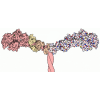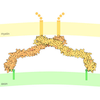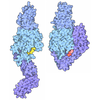[English] 日本語
 Yorodumi
Yorodumi- PDB-6f38: Cryo-EM structure of two dynein tail domains bound to dynactin an... -
+ Open data
Open data
- Basic information
Basic information
| Entry | Database: PDB / ID: 6f38 | |||||||||
|---|---|---|---|---|---|---|---|---|---|---|
| Title | Cryo-EM structure of two dynein tail domains bound to dynactin and HOOK3 | |||||||||
 Components Components |
| |||||||||
 Keywords Keywords | MOTOR PROTEIN / TDH / DDH / Complex / dynein/dynactin/HOOK3 | |||||||||
| Function / homology |  Function and homology information Function and homology informationRHOD GTPase cycle / Factors involved in megakaryocyte development and platelet production / retrograde axonal transport of mitochondrion / Regulation of actin dynamics for phagocytic cup formation / EPHB-mediated forward signaling / Adherens junctions interactions / VEGFA-VEGFR2 Pathway / Cell-extracellular matrix interactions / RHO GTPases Activate WASPs and WAVEs / MAP2K and MAPK activation ...RHOD GTPase cycle / Factors involved in megakaryocyte development and platelet production / retrograde axonal transport of mitochondrion / Regulation of actin dynamics for phagocytic cup formation / EPHB-mediated forward signaling / Adherens junctions interactions / VEGFA-VEGFR2 Pathway / Cell-extracellular matrix interactions / RHO GTPases Activate WASPs and WAVEs / MAP2K and MAPK activation / UCH proteinases / Gap junction degradation / Formation of annular gap junctions / RHOF GTPase cycle / Clathrin-mediated endocytosis / Formation of the dystrophin-glycoprotein complex (DGC) / dynactin complex / transport along microtubule / visual behavior / Regulation of PLK1 Activity at G2/M Transition / Loss of Nlp from mitotic centrosomes / Loss of proteins required for interphase microtubule organization from the centrosome / Anchoring of the basal body to the plasma membrane / AURKA Activation by TPX2 / F-actin capping protein complex / WASH complex / Recruitment of mitotic centrosome proteins and complexes / dynein light chain binding / dynein heavy chain binding / ciliary tip / cellular response to cytochalasin B / Intraflagellar transport / positive regulation of intracellular transport / regulation of transepithelial transport / regulation of metaphase plate congression / morphogenesis of a polarized epithelium / structural constituent of postsynaptic actin cytoskeleton / positive regulation of spindle assembly / barbed-end actin filament capping / protein localization to adherens junction / establishment of spindle localization / dense body / Neutrophil degranulation / Tat protein binding / postsynaptic actin cytoskeleton / coronary vasculature development / regulation of cell morphogenesis / dynein complex / adherens junction assembly / COPI-independent Golgi-to-ER retrograde traffic / retrograde axonal transport / apical protein localization / RHO GTPases activate IQGAPs / RHO GTPases Activate Formins / P-body assembly / HSP90 chaperone cycle for steroid hormone receptors (SHR) in the presence of ligand / microtubule motor activity / MHC class II antigen presentation / tight junction / Recruitment of NuMA to mitotic centrosomes / minus-end-directed microtubule motor activity / cytoplasmic dynein complex / dynein light intermediate chain binding / centrosome localization / COPI-mediated anterograde transport / aorta development / ventricular septum development / microtubule-based movement / nuclear migration / apical junction complex / regulation of norepinephrine uptake / transporter regulator activity / nitric-oxide synthase binding / cortical cytoskeleton / NuA4 histone acetyltransferase complex / establishment or maintenance of cell polarity / dynein intermediate chain binding / dynein complex binding / brush border / kinesin binding / regulation of synaptic vesicle endocytosis / microtubule-based process / regulation of protein localization to plasma membrane / positive regulation of double-strand break repair via homologous recombination / COPI-mediated anterograde transport / cytoplasmic microtubule / Amplification of signal from unattached kinetochores via a MAD2 inhibitory signal / cytoplasmic microtubule organization / cytoskeleton organization / axon cytoplasm / Mitotic Prometaphase / EML4 and NUDC in mitotic spindle formation / Loss of Nlp from mitotic centrosomes / Loss of proteins required for interphase microtubule organization from the centrosome / stress granule assembly / Recruitment of mitotic centrosome proteins and complexes / MHC class II antigen presentation / Recruitment of NuMA to mitotic centrosomes / axonogenesis / Anchoring of the basal body to the plasma membrane Similarity search - Function | |||||||||
| Biological species |  Homo sapiens (human) Homo sapiens (human) | |||||||||
| Method | ELECTRON MICROSCOPY / single particle reconstruction / cryo EM / Resolution: 6.7 Å | |||||||||
 Authors Authors | Lau, C.K. / Urnavicius, L. / Elshenawy, M.M. / Morales-Rios, E. / Motz, C. / Yildiz, A. / Carter, A.P. | |||||||||
| Funding support |  United Kingdom, 2items United Kingdom, 2items
| |||||||||
 Citation Citation |  Journal: Nature / Year: 2018 Journal: Nature / Year: 2018Title: Cryo-EM shows how dynactin recruits two dyneins for faster movement. Authors: Linas Urnavicius / Clinton K Lau / Mohamed M Elshenawy / Edgar Morales-Rios / Carina Motz / Ahmet Yildiz / Andrew P Carter /    Abstract: Dynein and its cofactor dynactin form a highly processive microtubule motor in the presence of an activating adaptor, such as BICD2. Different adaptors link dynein and dynactin to distinct cargoes. ...Dynein and its cofactor dynactin form a highly processive microtubule motor in the presence of an activating adaptor, such as BICD2. Different adaptors link dynein and dynactin to distinct cargoes. Here we use electron microscopy and single-molecule studies to show that adaptors can recruit a second dynein to dynactin. Whereas BICD2 is biased towards recruiting a single dynein, the adaptors BICDR1 and HOOK3 predominantly recruit two dyneins. We find that the shift towards a double dynein complex increases both the force and speed of the microtubule motor. Our 3.5 Å resolution cryo-electron microscopy reconstruction of a dynein tail-dynactin-BICDR1 complex reveals how dynactin can act as a scaffold to coordinate two dyneins side-by-side. Our work provides a structural basis for understanding how diverse adaptors recruit different numbers of dyneins and regulate the motile properties of the dynein-dynactin transport machine. | |||||||||
| History |
|
- Structure visualization
Structure visualization
| Movie |
 Movie viewer Movie viewer |
|---|---|
| Structure viewer | Molecule:  Molmil Molmil Jmol/JSmol Jmol/JSmol |
- Downloads & links
Downloads & links
- Download
Download
| PDBx/mmCIF format |  6f38.cif.gz 6f38.cif.gz | 1.8 MB | Display |  PDBx/mmCIF format PDBx/mmCIF format |
|---|---|---|---|---|
| PDB format |  pdb6f38.ent.gz pdb6f38.ent.gz | 1.3 MB | Display |  PDB format PDB format |
| PDBx/mmJSON format |  6f38.json.gz 6f38.json.gz | Tree view |  PDBx/mmJSON format PDBx/mmJSON format | |
| Others |  Other downloads Other downloads |
-Validation report
| Summary document |  6f38_validation.pdf.gz 6f38_validation.pdf.gz | 1.8 MB | Display |  wwPDB validaton report wwPDB validaton report |
|---|---|---|---|---|
| Full document |  6f38_full_validation.pdf.gz 6f38_full_validation.pdf.gz | 1.8 MB | Display | |
| Data in XML |  6f38_validation.xml.gz 6f38_validation.xml.gz | 246.4 KB | Display | |
| Data in CIF |  6f38_validation.cif.gz 6f38_validation.cif.gz | 436.3 KB | Display | |
| Arichive directory |  https://data.pdbj.org/pub/pdb/validation_reports/f3/6f38 https://data.pdbj.org/pub/pdb/validation_reports/f3/6f38 ftp://data.pdbj.org/pub/pdb/validation_reports/f3/6f38 ftp://data.pdbj.org/pub/pdb/validation_reports/f3/6f38 | HTTPS FTP |
-Related structure data
| Related structure data |  4177MC  4168C  4169C  4170C  4171C  4172C  5owoC  6f1tC  6f1uC  6f1vC  6f1yC  6f1zC  6f3aC M: map data used to model this data C: citing same article ( |
|---|---|
| Similar structure data |
- Links
Links
- Assembly
Assembly
| Deposited unit | 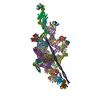
|
|---|---|
| 1 |
|
- Components
Components
-Protein , 8 types, 19 molecules ABCDEFGIHJKLUXxklst
| #1: Protein | Mass: 42670.688 Da / Num. of mol.: 8 / Source method: isolated from a natural source / Details: ADP: Adenosine Diphosphate / Source: (natural)  #2: Protein | | Mass: 41782.660 Da / Num. of mol.: 1 / Source method: isolated from a natural source / Details: ATP: Adenosine triphosphate / Source: (natural)  #3: Protein | | Mass: 43203.250 Da / Num. of mol.: 1 / Source method: isolated from a natural source / Details: ADP: Adenosine diphosphate / Source: (natural)  #4: Protein | | Mass: 33059.848 Da / Num. of mol.: 1 / Source method: isolated from a natural source / Source: (natural)  #5: Protein | | Mass: 30669.768 Da / Num. of mol.: 1 / Source method: isolated from a natural source / Source: (natural)  #10: Protein | | Mass: 20703.910 Da / Num. of mol.: 1 / Source method: isolated from a natural source / Source: (natural)  #12: Protein | Mass: 18996.346 Da / Num. of mol.: 2 Source method: isolated from a genetically manipulated source Source: (gene. exp.)  Homo sapiens (human) / Production host: Homo sapiens (human) / Production host:  #22: Protein | Mass: 10934.576 Da / Num. of mol.: 4 Source method: isolated from a genetically manipulated source Source: (gene. exp.)  Homo sapiens (human) / Gene: DYNLRB1, BITH, DNCL2A, DNLC2A, ROBLD1, HSPC162 / Production host: Homo sapiens (human) / Gene: DYNLRB1, BITH, DNCL2A, DNLC2A, ROBLD1, HSPC162 / Production host:  |
|---|
-Dynactin Subunit ... , 12 types, 14 molecules MNOPQRVYZabcdz
| #6: Protein | Mass: 49974.707 Da / Num. of mol.: 1 / Source method: isolated from a natural source / Source: (natural)  | ||||||||||||||||||
|---|---|---|---|---|---|---|---|---|---|---|---|---|---|---|---|---|---|---|---|
| #7: Protein | Mass: 52442.777 Da / Num. of mol.: 1 / Source method: isolated from a natural source / Source: (natural)  | ||||||||||||||||||
| #8: Protein | Mass: 5549.833 Da / Num. of mol.: 2 / Source method: isolated from a natural source / Source: (natural)  #9: Protein | Mass: 7422.140 Da / Num. of mol.: 2 / Source method: isolated from a natural source / Source: (natural)  #11: Protein | | Mass: 20150.533 Da / Num. of mol.: 1 / Source method: isolated from a natural source / Source: (natural)  #13: Protein | | Mass: 22485.607 Da / Num. of mol.: 1 / Source method: isolated from a natural source / Source: (natural)  #14: Protein | | Mass: 4443.468 Da / Num. of mol.: 1 / Source method: isolated from a natural source / Source: (natural)  #15: Protein | | Mass: 7578.217 Da / Num. of mol.: 1 / Source method: isolated from a natural source / Source: (natural)  #16: Protein | | Mass: 10147.034 Da / Num. of mol.: 1 / Source method: isolated from a natural source / Source: (natural)  #17: Protein/peptide | | Mass: 5551.896 Da / Num. of mol.: 1 / Source method: isolated from a natural source / Source: (natural)  #18: Protein/peptide | | Mass: 3239.433 Da / Num. of mol.: 1 / Source method: isolated from a natural source / Source: (natural)  #23: Protein | | Mass: 4528.573 Da / Num. of mol.: 1 / Source method: isolated from a natural source / Source: (natural)  |
-Cytoplasmic dynein 1 ... , 3 types, 12 molecules efmnghopijqr
| #19: Protein | Mass: 168318.781 Da / Num. of mol.: 4 Source method: isolated from a genetically manipulated source Source: (gene. exp.)  Homo sapiens (human) / Gene: DYNC1H1, DHC1, DNCH1, DNCL, DNECL, DYHC, KIAA0325 / Cell line (production host): Sf9 / Production host: Homo sapiens (human) / Gene: DYNC1H1, DHC1, DNCH1, DNCL, DNECL, DYHC, KIAA0325 / Cell line (production host): Sf9 / Production host:  #20: Protein | Mass: 68442.141 Da / Num. of mol.: 4 Source method: isolated from a genetically manipulated source Source: (gene. exp.)  Homo sapiens (human) / Gene: DYNC1I2, DNCI2, DNCIC2 / Production host: Homo sapiens (human) / Gene: DYNC1I2, DNCI2, DNCIC2 / Production host:  #21: Protein | Mass: 54173.156 Da / Num. of mol.: 4 Source method: isolated from a genetically manipulated source Source: (gene. exp.)  Homo sapiens (human) / Gene: DYNC1LI2, DNCLI2, LIC2 / Production host: Homo sapiens (human) / Gene: DYNC1LI2, DNCLI2, LIC2 / Production host:  |
|---|
-Non-polymers , 2 types, 10 molecules 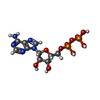
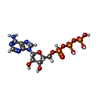

| #24: Chemical | ChemComp-ADP / #25: Chemical | ChemComp-ATP / | |
|---|
-Experimental details
-Experiment
| Experiment | Method: ELECTRON MICROSCOPY |
|---|---|
| EM experiment | Aggregation state: PARTICLE / 3D reconstruction method: single particle reconstruction |
- Sample preparation
Sample preparation
| Component |
| ||||||||||||||||||||||||||||||
|---|---|---|---|---|---|---|---|---|---|---|---|---|---|---|---|---|---|---|---|---|---|---|---|---|---|---|---|---|---|---|---|
| Source (natural) |
| ||||||||||||||||||||||||||||||
| Source (recombinant) |
| ||||||||||||||||||||||||||||||
| Buffer solution | pH: 7.2 | ||||||||||||||||||||||||||||||
| Specimen | Embedding applied: NO / Shadowing applied: NO / Staining applied: NO / Vitrification applied: YES | ||||||||||||||||||||||||||||||
| Vitrification | Cryogen name: ETHANE |
- Electron microscopy imaging
Electron microscopy imaging
| Experimental equipment |  Model: Titan Krios / Image courtesy: FEI Company |
|---|---|
| Microscopy | Model: FEI TITAN KRIOS |
| Electron gun | Electron source:  FIELD EMISSION GUN / Accelerating voltage: 300 kV / Illumination mode: FLOOD BEAM FIELD EMISSION GUN / Accelerating voltage: 300 kV / Illumination mode: FLOOD BEAM |
| Electron lens | Mode: BRIGHT FIELD |
| Image recording | Electron dose: 45 e/Å2 / Detector mode: INTEGRATING / Film or detector model: FEI FALCON III (4k x 4k) |
- Processing
Processing
| Software | Name: PHENIX / Version: dev_2919: / Classification: refinement | ||||||||||||||||||||||||
|---|---|---|---|---|---|---|---|---|---|---|---|---|---|---|---|---|---|---|---|---|---|---|---|---|---|
| EM software |
| ||||||||||||||||||||||||
| CTF correction | Type: PHASE FLIPPING AND AMPLITUDE CORRECTION | ||||||||||||||||||||||||
| Symmetry | Point symmetry: C1 (asymmetric) | ||||||||||||||||||||||||
| 3D reconstruction | Resolution: 6.7 Å / Resolution method: FSC 0.143 CUT-OFF / Num. of particles: 23407 / Symmetry type: POINT | ||||||||||||||||||||||||
| Atomic model building | Protocol: FLEXIBLE FIT / Space: REAL / Target criteria: Corellation Coefficient | ||||||||||||||||||||||||
| Refine LS restraints |
|
 Movie
Movie Controller
Controller


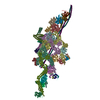


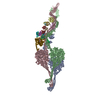

 PDBj
PDBj


